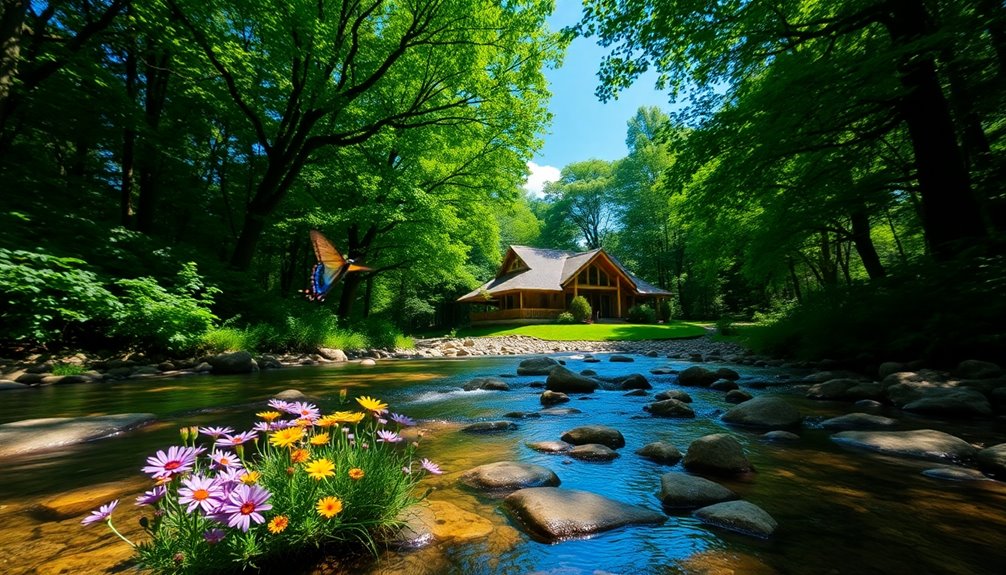In Eco-Friendly India, you'll discover hidden gems that seamlessly blend lush landscapes with rich culture. Visit the Valley of Flowers National Park, where over 500 species bloom spectacularly. Explore Sikkim, home to thousands of plant and bird species, or the Khasi tribe's Living Root Bridges, showcasing sustainability. Engage with local communities through eco-friendly accommodations and sustainable wildlife safaris, enhancing your travel experience. And don't miss seasonal festivals that celebrate nature. Every choice you make supports conservation, enriching both your journey and the environment. Keep exploring to uncover more eco-conscious treasures waiting for you in India!
Key Takeaways
- Explore the Valley of Flowers National Park, home to over 500 flowering plant species, showcasing India's rich biodiversity and ecological preservation efforts.
- Visit the Living Root Bridges in Meghalaya, a sustainable marvel created by the Khasi tribe, exemplifying harmony between nature and local culture.
- Experience the Khonoma sanctuary, a model of community-led environmental protection, where locals actively engage in conservation initiatives and sustainable practices.
- Participate in eco-friendly festivals like Sekrenyi in Jotsoma Village, promoting ecological awareness while immersing in local customs and traditions.
- Choose eco-friendly accommodations that utilize solar power and local materials to support sustainable tourism and enhance your travel experience in India.
Introduction
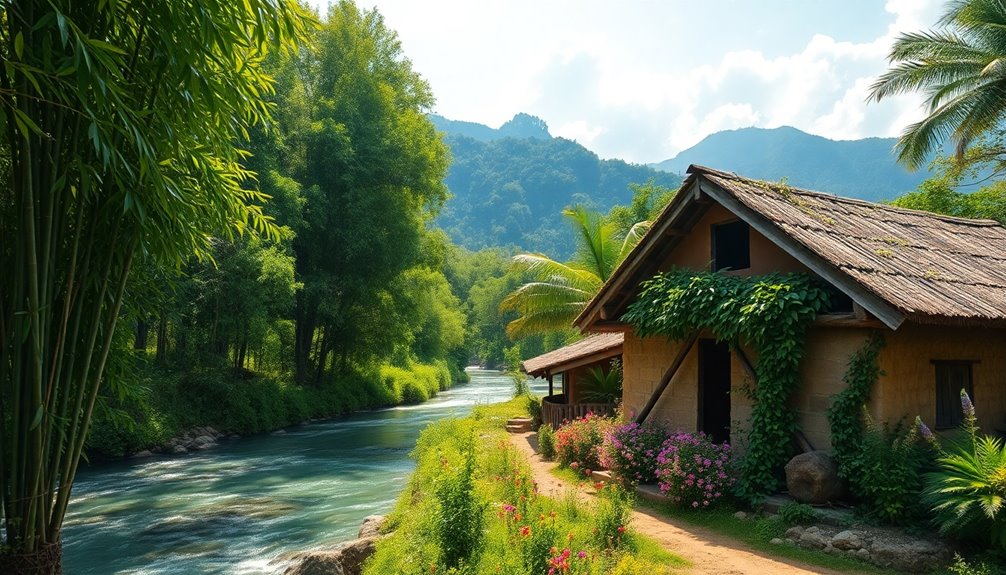
India's eco-friendly destinations showcase a stunning blend of cultural richness and biodiversity that you won't want to miss.
By visiting these hidden gems, you help preserve the natural heritage and unique traditions of local communities.
Each destination offers a chance to connect with nature while supporting sustainable practices that benefit both the environment and the culture.
Cultural Richness and Biodiversity
With over 500 flowering plant species, the Valley of Flowers National Park in Uttarakhand stands as a testament to the incredible biodiversity found across India's diverse ecosystems.
You'll discover that places like Sikkim, home to 4,000 plant species and 600 bird species, showcase the region's commitment to cultural richness and ecological preservation.
The Khasi tribe in Meghalaya exemplifies sustainable practices through their Living Root Bridges, blending human creativity with nature.
Mawlynnong, Asia's cleanest village, promotes eco-tourism initiatives like composting and rainwater harvesting, emphasizing community involvement in environmental stewardship.
Meanwhile, the Khonoma sanctuary in Nagaland serves as a model for environmental protection, proving how local communities can play a pivotal role in preserving both cultural and ecological heritage. Additionally, the region's diverse flora includes plants with anti-inflammatory properties, highlighting the connection between nature and health benefits.
Preserve Natural Heritage and Culture
In the quest to celebrate and protect the environment, eco-tourism plays a pivotal role in preserving natural heritage and culture. By embracing sustainable travel, you can explore eco-tourism destinations like Mawlynnong and Thenmala, where conservation efforts thrive alongside local traditions.
These hidden gems offer stunning natural landscapes and a rich cultural heritage that's deeply intertwined with environmental stewardship. For instance, the Sekrenyi festival in Jotsoma Village showcases local customs while promoting ecological awareness.
Meanwhile, the Khangchendzonga Biosphere Reserve in Sikkim emphasizes biodiversity conservation, highlighting its importance in maintaining the region's ecological balance. Engaging with these communities not only enriches your travel experience but also supports initiatives that protect both nature and culture for future generations.
Travel From New York City
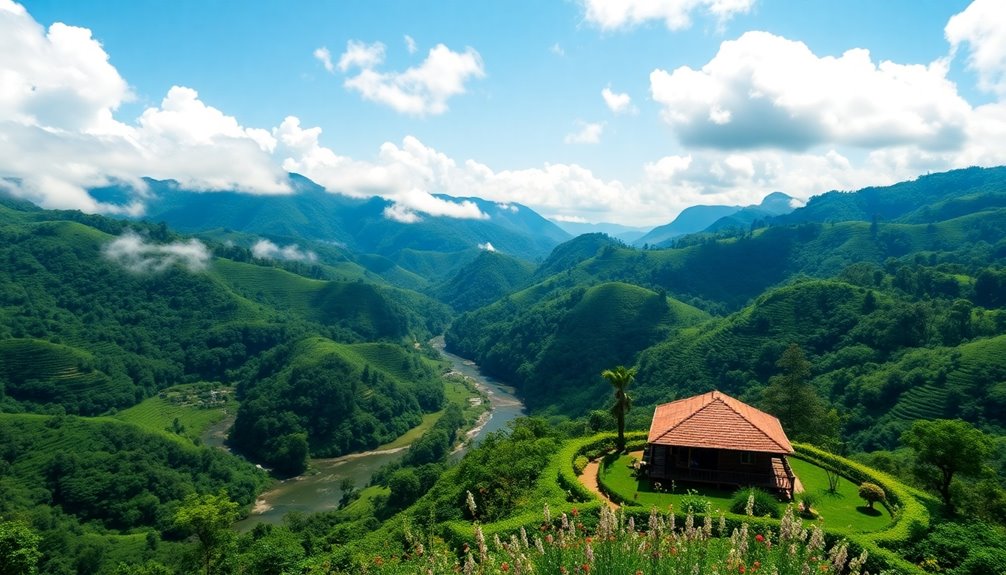
When you fly from New York City to India, you're in for a long journey, typically lasting 15-20 hours with layovers.
Once you arrive, you'll find eco-friendly options like rickshaw services that make your travels more sustainable.
Whether you're exploring bustling cities or serene landscapes, the greenest hidden gems of India await you.
Fly From Los Angeles to India
Traveling from Los Angeles to India offers a unique adventure, especially if you start your journey in New York City.
With major airlines like Air India, United, and Emirates, you can explore the hidden gems of India while enjoying eco-friendly initiatives during your flight.
Here's how you can make the most of your trip:
- Book your flight 2-3 months in advance for competitive rates.
- Expect an average travel time of 18 to 24 hours, including layovers.
- Discover nature through sustainable agriculture practices upon arrival.
- Participate in adventure activities in eco-friendly destinations like Kerala and Sikkim.
This journey not only opens doors to rich culture but also emphasizes responsible tourism, so you can truly appreciate India's greenest hidden gems.
Travel From London to India
Booking your flight from London to India can be an exciting step toward discovering the country's eco-friendly treasures. Major airlines connect London to various Indian cities, with popular entry points like Delhi and Mumbai.
Once you arrive, you'll find lush landscapes and vibrant cultural experiences awaiting you. For nature enthusiasts, exploring wildlife sanctuaries is a must, where you can witness India's incredible biodiversity.
To enhance your journey, consider sustainable travel options like eco-friendly accommodations and local transportation methods such as trains or buses. These choices not only support conservation efforts but also enrich your overall experience. Regular maintenance of your travel gear, much like ceiling fan maintenance, can also ensure a safer and more enjoyable trip.
With an e-Visa, you can easily explore India's greenest hidden gems while immersing yourself in its unique cultural and natural heritage.
Travel From Sydney to India
Flying from Sydney to India opens up a world of eco-friendly adventures waiting to be explored.
With a flight duration of around 14 to 16 hours, you'll land in a country rich in biodiversity and sustainable tourism options.
Don't miss out on these eco-tourism gems:
- Visit Mawlynnong Village, Asia's cleanest village, to learn about community-driven initiatives.
- Trek through the lush landscapes of Coorg, known for its coffee plantations and natural beauty.
- Discover Thenmala in Kerala, India's first planned eco-tourism destination, perfect for trekking and bird watching.
- Relax on the pristine beaches of Agatti Island in Lakshadweep, promoting sustainable practices.
Experiencing these destinations aligns with the principles of Leave No Trace, ensuring minimal impact on the environment.
These experiences await adventure enthusiasts eager to embrace India's eco-friendly charm.
Eco-Friendly Rickshaw Services Available
While exploring the vibrant streets of India, you'll find that eco-friendly rickshaw services offer a sustainable way to navigate the bustling cities.
Many urban areas, like Delhi and Jaipur, have embraced electric rickshaws (e-rickshaws) as a cleaner alternative to traditional auto-rickshaws. These e-rickshaws, powered by rechargeable batteries, significantly reduce carbon emissions and improve urban air quality.
With over 1.5 million units registered as of 2023, they not only support eco-tourism but also foster local economies. By choosing rickshaw services, you're contributing to a more sustainable travel experience while discovering India's rich culture and stunning landscapes.
Sustainable Wildlife Safaris
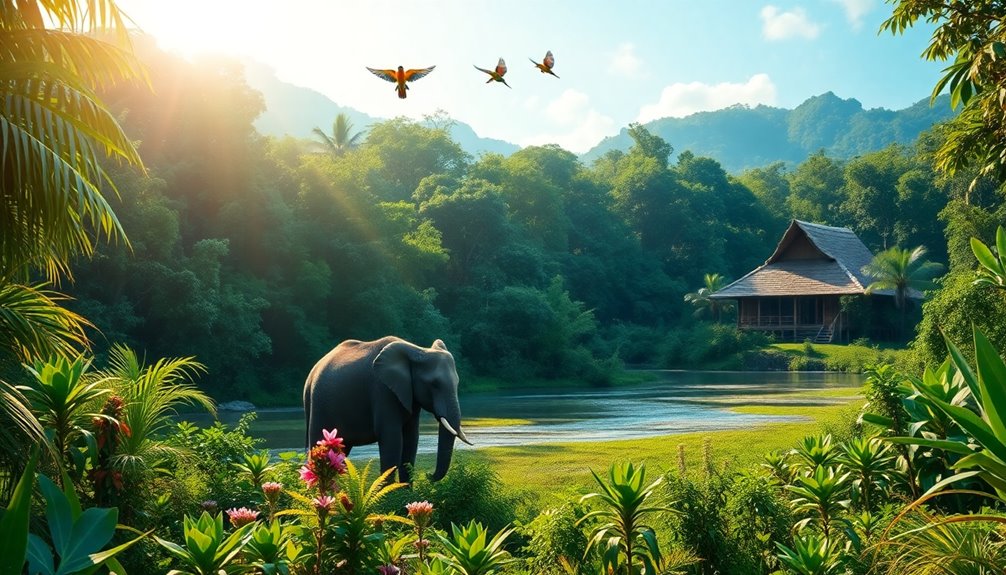
When you choose sustainable wildlife safaris in India, you're not just enjoying breathtaking views; you're also supporting vital conservation efforts.
These experiences often include wildlife conservation volunteer programs that let you actively contribute while learning about local ecosystems.
Plus, with options like solar-powered lodges and sustainable hiking trails, your adventure can leave a minimal impact on the environment.
Wildlife Conservation Volunteer Programs
Embarking on a wildlife conservation volunteer program in India offers you a unique chance to make a real difference in protecting the country's rich biodiversity.
As a wildlife enthusiast, you'll engage in hands-on activities that help preserve endangered animals and their habitats.
You'll get to:
- Participate in conservation research to monitor wildlife populations.
- Restore habitats and implement sustainable practices.
- Support community education efforts, promoting coexistence with local species.
- Work alongside experienced conservationists in diverse ecosystems.
These programs not only deepen your understanding of wildlife challenges but also foster responsible tourism, ensuring that your efforts contribute positively to local economies and the environment.
Join a program and play an active role in India's wildlife conservation!
Sustainable Hiking and Trekking
How can you explore India's breathtaking landscapes while preserving its natural beauty? By embracing sustainable hiking and trekking, you can enjoy the country's stunning scenery while minimizing your impact on local ecosystems.
Popular spots like Dzukou Valley and Chembra Peak offer guided tours that promote responsible travel and cultural awareness.
For wildlife enthusiasts, eco-tourism in parks such as Kanha and Bandipur focuses on educational experiences led by trained naturalists. They'll help you appreciate the vital role of biodiversity and the importance of habitat preservation.
Engage with local communities, ensuring that the revenue from your adventures supports conservation efforts and livelihoods.
With the rise of eco-conscious travelers, you'll find increasing options for low-impact wildlife safaris, making your journey both enriching and responsible.
Solar-Powered Lodges and Cabins
After enjoying sustainable hiking and trekking, consider extending your eco-friendly journey by staying in solar-powered lodges and cabins.
These accommodations not only offer sustainable lodging but also support eco-tourism and conservation efforts. You'll experience the beauty of India while minimizing your environmental impact.
Here's what you can expect:
- Energy-efficient amenities like solar-heated water and lighting.
- Local materials and designs that blend with nature.
- Wildlife safaris that respect ecosystems and support local communities.
- Sustainable waste management systems that promote responsible travel.
Staying in solar-powered lodges allows you to immerse yourself in nature while embracing a lifestyle that prioritizes sustainability. Additionally, the use of solar energy in these lodges contributes to reductions in energy costs for consumers and promotes environmental benefits.
Enjoy a unique adventure that contributes to conservation and a greener planet!
Support Local Eco-Friendly Businesses
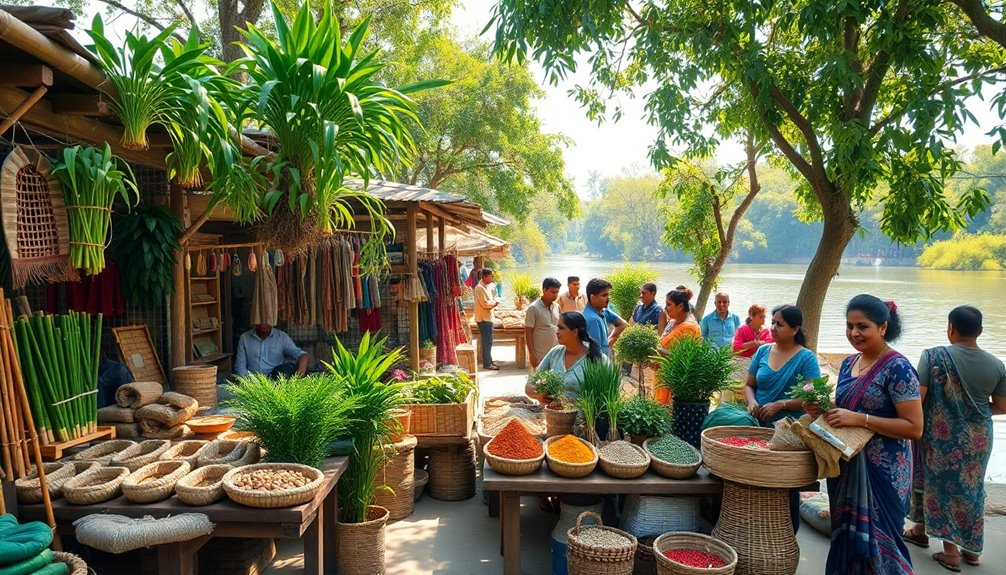
When you support local eco-friendly businesses, you not only contribute to sustainable development but also help preserve the unique cultural heritage of India.
By choosing eco-friendly accommodations like homestays in Sikkim or eco-lodges in Kerala, you prioritize sustainability and enjoy locally sourced organic food.
Purchasing locally made crafts in markets like Mawlynnong and Khonoma ensures that traditional arts thrive and artisans can sustain their livelihoods.
Engaging with eco-friendly adventure companies for guided treks in Spiti Valley or wildlife safaris in Kanha National Park deepens your appreciation for biodiversity and promotes responsible tourism practices.
Every purchase and experience helps bolster economic resilience in local communities, making your travels more meaningful and impactful. Additionally, consider supporting local artisans who create sustainable crafts that reflect the region's rich heritage and environmental consciousness.
Community-Led Tree Planting Programs
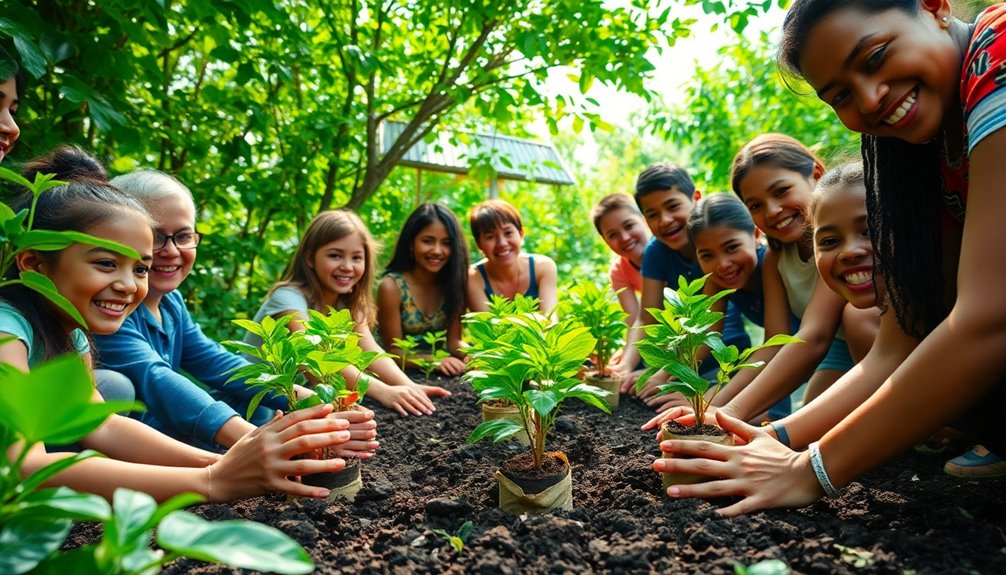
You'll find that community-led tree planting programs in India thrive thanks to strong collaborations between government bodies and NGOs.
These efforts not only boost forest cover but also enhance cultural sustainability by engaging local residents in conservation.
Government and NGO Efforts
As community-led tree planting programs flourish across India, both government initiatives and NGOs play crucial roles in fostering environmental stewardship.
These collaborative efforts have led to significant advancements in afforestation and biodiversity restoration. Here are some highlights:
- The "Green India Mission" aims to increase forest cover by 5 million hectares by 2022.
- NGOs like "Grow-Trees" have planted over 2 million trees, emphasizing community engagement.
- The "Miyawaki Method" promotes dense urban forests, with thousands of native trees planted rapidly.
- Initiatives such as "Haritha Keralam" target planting 10 million trees by 2025 as part of climate action.
These programs empower local communities, ensuring sustainable land management while enhancing green spaces across the nation.
Community and Cultural Sustainability
Building on the impressive initiatives by the government and NGOs, community-led tree planting programs are gaining momentum across India. These grassroots efforts are crucial for sustainability, combating deforestation, and enhancing biodiversity.
By actively engaging over 1,000 villages in afforestation activities, local communities foster a sense of ownership and responsibility towards their environment. Programs utilizing the Miyawaki method allow you to plant dense, native forests in small areas, leading to quicker environmental change.
As community members sell fruits and produce from the newly planted trees, they contribute to local economies while creating green spaces. Successful projects in Maharashtra and Kerala showcase how collective action can lead to significant environmental benefits and a brighter, greener future for everyone involved. Additionally, these efforts promote sustainable foraging practices that ensure both food security and ecological balance in the region.
Monsoon Season for Lush Landscapes
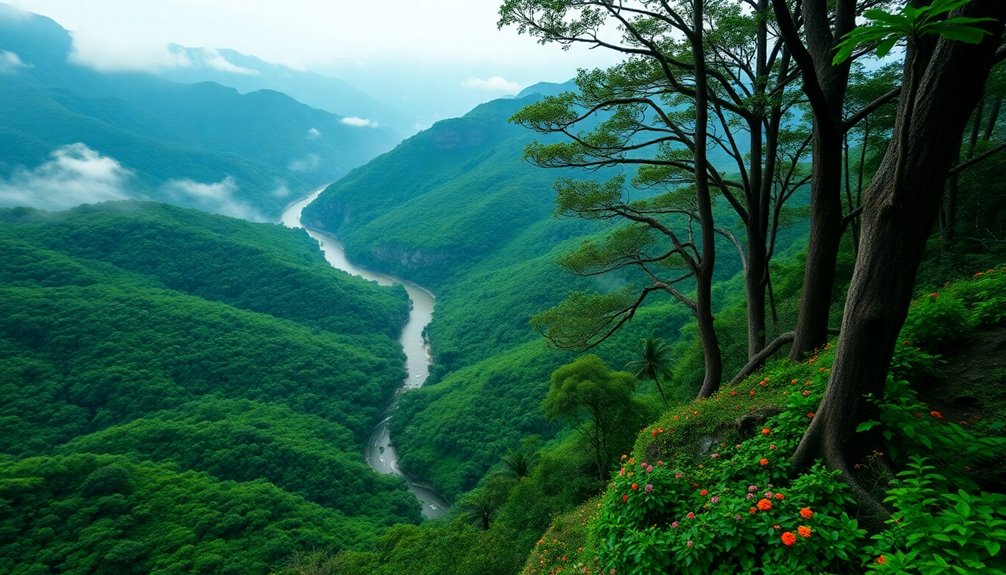
During the monsoon season, you'll witness India's landscapes transform into lush green paradises, perfect for exploring hidden gems.
As you trek through vibrant regions, don't miss the chance to experience seasonal festivals that celebrate this natural bounty.
Plus, the cooler temperatures create an ideal backdrop for wildlife viewing, making your adventure even more unforgettable.
Winter for Wildlife Viewing
While winter in India brings cooler temperatures and a vibrant wildlife scene, the monsoon season transforms landscapes into lush green paradises filled with life.
During the winter season, head to national parks where diverse wildlife is more active and often spotted near water sources. You'll have the chance to see migratory birds flocking to places like Bharatpur Bird Sanctuary.
To make the most of your wildlife viewing experience, consider these tips:
- Visit high-altitude destinations like Tawang for snow leopards
- Explore Periyar National Park for lush greenery and rich biodiversity
- Capture stunning wildlife photography opportunities
- Enjoy serene moments in Kanha National Park surrounded by nature
Embrace the beauty of winter and its incredible wildlife!
Seasonal Festivals Enhance Travel Experience
Have you ever experienced the magic of India during the monsoon season? This time of year transforms landscapes into lush greenery, revealing breathtaking views at places like Dzukou Valley and Chembra Peak.
Seasonal festivals, such as the Ziro Music Festival in Arunachal Pradesh, add to the experience with cultural performances set against the stunning backdrop of vibrant flora and rice fields.
Eco-tourism thrives during this period, especially in Mawlynnong Village, where you can immerse yourself in local traditions while surrounded by natural beauty.
Don't miss the spectacular sight of Chitrakote Falls, flowing fiercely amidst lush forests.
The rich biodiversity during the monsoon also attracts wildlife enthusiasts to Kanha National Park, enhancing your overall travel experience. Additionally, travelers can enjoy the benefits of eco-friendly power solutions like solar panels for camping, which allow for sustainable energy use while exploring these beautiful landscapes.
How to Make Your Trip More Sustainable
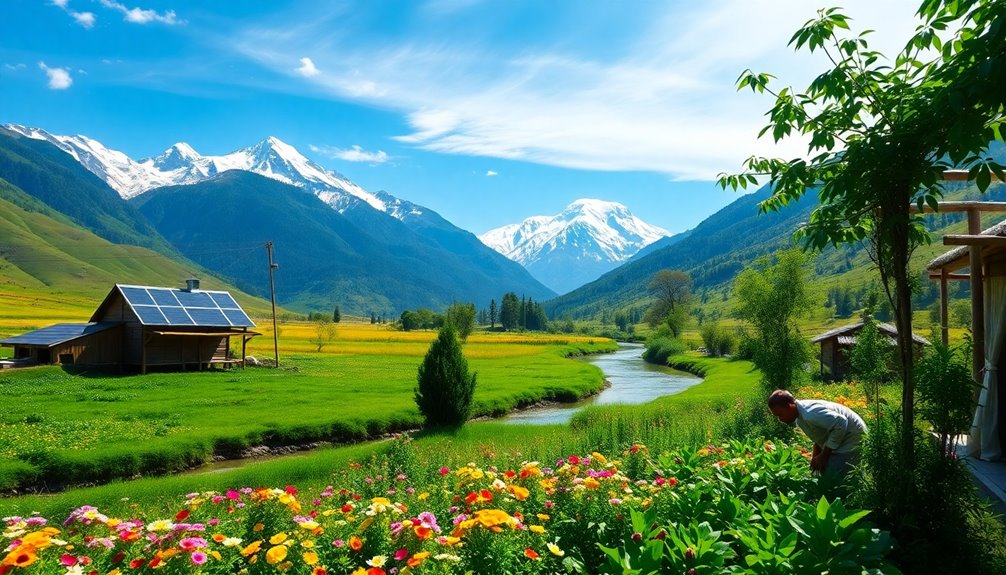
When planning your trip, consider packing biodegradable toiletries and containers to reduce waste in the beautiful environments you visit.
Supporting local artisans and crafts not only enriches your experience but also helps sustain local economies and cultures. Additionally, using essential oils can enhance your travel experience through aromatherapy, promoting relaxation and well-being during your journey.
Biodegradable Toiletries and Containers
Traveling sustainably doesn't have to be complicated, especially when you choose biodegradable toiletries and containers. By making a sustainable choice, you can minimize environmental impact while enjoying your trip.
Here are some eco-friendly options to consider:
- Use bamboo toothbrushes and compostable soap bars to reduce plastic waste.
- Opt for biodegradable containers made from palm leaves or cornstarch for food and beverages.
- Pack travel-sized products from eco-conscious brands that break down naturally.
- Switch to biodegradable wet wipes made from natural fibers to prevent pollution.
These small changes promote eco-friendly product usage and help you travel responsibly while exploring India's hidden gems. Additionally, choosing water-efficient toilets can further contribute to reducing your environmental footprint during your travels.
Embrace these alternatives to ensure your adventures leave a positive mark on the planet!
Support Local Artisans and Crafts
Supporting local artisans and crafts not only enriches your travel experience but also fosters sustainable practices that benefit communities.
When you buy handmade products, like the unique Ikat weavings from Parigi, you support local artisans and help create sustainable livelihoods. Engage with artisans through workshops for authentic cultural experiences, deepening your understanding of their traditional crafts.
Opting for locally-made items over mass-produced souvenirs helps minimize your carbon footprint and promotes eco-friendly materials. Attend local festivals, such as Durga Puja in Balasore, to witness the beauty of traditional craftsmanship firsthand.
By choosing products made from natural resources, like terracotta from Bishnupur, you not only support these artisans but also contribute to environmental sustainability.
In addition, many traditional crafts, such as bamboo weaving, are deeply rooted in Indonesia's cultural heritage, showcasing the importance of preserving these skills for future generations.
Your choices matter!
Frequently Asked Questions
What Is the Hidden Gem of India?
When you think of hidden gems in India, Dzukou Valley in Nagaland might come to mind. Its vibrant wildflowers and stunning trekking trails invite you to explore nature's beauty.
Alternatively, the Living Root Bridges in Meghalaya showcase incredible sustainable engineering.
You might also consider Agatti Island, perfect for snorkeling among coral reefs.
Each of these places offers unique experiences that connect you with India's rich natural heritage while promoting eco-friendly practices.
How Eco-Friendly Is India?
India's eco-friendliness is evident in its various initiatives and practices.
You'll find that the government promotes renewable energy sources, and communities actively participate in sustainability efforts, like waste management and clean drinking water projects.
Places like Sikkim and Mawlynnong showcase successful eco-tourism models, highlighting local involvement in conservation.
As you explore, you'll see how these efforts contribute to a greener future while enhancing the country's natural beauty and biodiversity.
Which Is the First Eco-Friendly Tourism in India?
Think of Thenmala as a green heartbeat in India's eco-tourism landscape. It's the first planned eco-tourism destination, where sustainable practices thrive.
Established in 1991, you can immerse yourself in trekking, bird watching, or river rafting without leaving a trace.
You'll witness local communities actively participating in conservation, ensuring the region's natural beauty endures.
Which Is the First Eco-Friendly Tourist Village in India?
The first eco-friendly tourist village in India is Mawlynnong, located in Meghalaya.
You'll find it's not just a picturesque spot; the community actively practices sustainable living. They've implemented impressive waste management systems, like composting and rainwater harvesting, making it Asia's cleanest village.
When you visit, you can explore stunning natural attractions like the Living Root Bridge while immersing yourself in the rich Khasi culture and supporting local biodiversity efforts.
Conclusion
As you embark on your journey through India's greenest treasures, think of yourself as a seed planted in rich, fertile soil. Nurtured by the vibrant culture and sustainable practices around you, your travels can blossom into a deeper connection with nature. By supporting eco-friendly businesses and engaging in community initiatives, you're not just a visitor; you're a gardener tending to the planet. So, let your adventures flourish and sow the seeds of change for a greener tomorrow.

